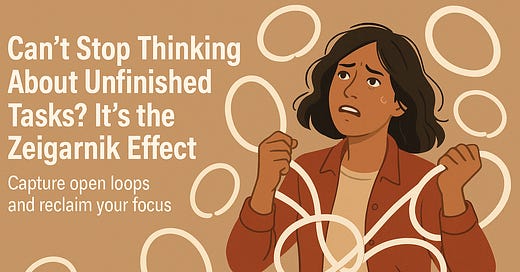Can't Stop Thinking About Unfinished Tasks? It's the Zeigarnik Effect
Your brain's natural tendency to track unfinished business can either drain or support you. Here's how to work with it instead of against it.
Ever notice how it’s easier to obsess over the one thing you didn’t finish today than the twenty things you did?
That’s not just you — it’s human wiring. It’s called the Zeigarnik Effect.
Back in the 1920s, a psychologist named Bluma Zeigarnik was sitting in a café when she noticed something weird. The waiters had perfect recall of unpaid orders, but the moment a table settled up? Poof. Those details vanished like steam off a coffee cup.
This wasn’t just about waiters and their tabs. When Zeigarnik dug deeper, she discovered something fundamental about how our brains work: Unfinished tasks take up mental real estate.
Your brain treats incomplete tasks like a persistent alarm system, keeping them front and center until you either handle them or explicitly tell your brain “we’ve got this covered.”
Your Brain’s Not Broken (But Modern Life Might Be)
This mental alert system worked great when we were dealing with simpler tasks like “find food” or “build shelter.”
But today?
Your brain is trying to track:
Six email threads that need responses
That Slack message you half-read
Comments and reactions from 37 different social media posts you flipped through and made a little mental note to return to
Three Google docs waiting for comments
The text you forgot to send
That weird tension from yesterday’s meeting
The dentist appointment you need to schedule
And about 197 other things you started but haven’t finished
Each creates an open loop in your mind, and these loops don’t sit quietly. They create drag, like dozens of apps running in the background of your phone. Each one slowly drains your battery. The cognitive drag shows up as that fuzzy inability to focus or that weird mental exhaustion even when you “haven’t done anything.”
The emotional drag feels like that constant low-grade anxiety that you’re forgetting something important, even if you can’t quite name what it is.
And it turns out that the size of the task doesn’t even matter. Your brain gives “reschedule dentist appointment” the same urgency as “finish major project proposal.” The incompleteness matters more than importance.
Yes, this explains why you have to be careful about just working through an unprioritized list of action items. Your brain is optimizing for open loops, not importance. That’s how, thirty minutes before we know we actually need to be done, we remember all the important stuff we didn’t get to. A day of little dopamine hits from completing a task resolves with dread when you see the first things didn’t get done.
How to Work With Your Brain, Not Against It
You can’t engineer the Zeigarnik Effect away and you wouldn’t want to. It helps make sure you don’t burn food, attend to people and pets under your care, and make sure you leave the house with everything you need.
It often just can’t differentiate between what needs to happen now versus later. The goal is to give those open loops better homes and holding places.
Here’s how:
Capture everything. A single clear note can close an open loop. “Send draft to Karen by Friday” is much lighter on the mind than “ugh, I still need to email Karen about something…” (The Action Item Catcher is great for this.)
Create breadcrumbs that close the loop and help you pick it back up later. End meetings by naming next steps. End your day by writing down tomorrow’s starting point. Tell your brain: “You’re safe to let this go.”
Make loop-closing a regular practice with the 10/15 Split and regular admin blocks. The 10/15 Split creates a daily practice for closing loops that keeps them from piling up on you. You may find a couple of 30-60 minute admin blocks helpful to surface or close those follow-ups, check-ins, and CAT work that keep accumulating. Think of these practices as regular maintenance for your mental alert system.
Don't skip the emotional loops. Sometimes what's unfinished isn't a task — it's that conversation that ended weird or that decision you're not quite sure about. A quick “I’ve been thinking about what you said...” message or 10 minutes mind-mapping your feelings can clear more mental RAM than you’d expect.
A note about capturing versus closing loops: while capturing helps, sometimes you’re better off noting the loop and moving on, especially during focus blocks. This is where the two-minute rule from Getting Things Done needs some discernment. Breaking your flow to handle a quick task often costs more than capturing the loop and returning to it later.
Why Closing Loops Is About More Than Getting More Stuff Done
These loop-clearing practices aren’t just about getting more stuff done during the day. They’re about reclaiming your mental and emotional space from all those unfinished loops that keep shouting for attention so you can be present and focused in any given moment.
When we let open loops run wild, they end up running us instead. They steal our focus when we’re trying to create, keep us awake when we need to rest, create urgency spirals, and nibble away at our peace of mind even during moments that should be joyful.
But when we learn to catch them, close them, or consciously set them aside? That’s when we get back the mental space to think deeply, be present with who and what’s in front of us, and actually enjoy what we’re doing instead of always worrying about what we’re not doing.
And isn’t that the whole point?






This is so helpful! And I forwarded it to five people I thought would think so, too. BTW, I return to "Start Finishing" over and over for periodic kicks in the butt and inspiration. Thanks, so much for the many great insights and mind hacks.